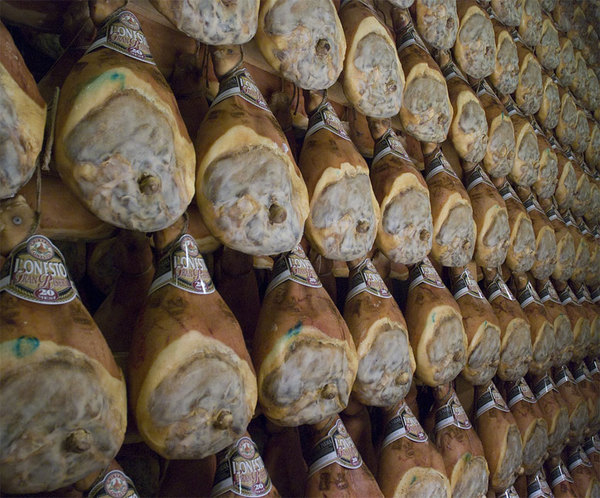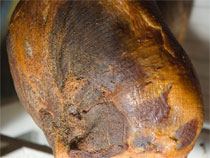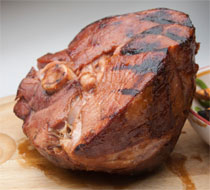how long to cook a fresh ham

Ham is an Easter favorite, and I get emails from people at this time of year asking how to cook one. The first question I have to ask is which kind of ham do you have? A true ham is a rear leg of a hog from hip to knee. Most have a bone in it, but some are boneless. Sounds simple, right? I wish. There are exceptions, the picnic ham, which comes from the lower part of the front leg, and the turkey ham, which comes from a fowl (whose idea was this?). Let's clarify the murk. Here's what you need to know when shopping for a ham and tips for cooking it. Folks who follow me here weekly know my specialty is outdoor cooking, but these tips can easily be adapted for indoors.
Three major categories
Fresh Ham (a.k.a. Leg)
is a raw uncured uncooked ham, usually with the skin still on. The meat is the typical pale pink to beige color of raw pork. It can be roasted, skin on or off, and it is especially good with the skin removed and smoke roasted. Use the skin for
.
 Dry-Cured Ham is cured (preserved) by burying it a big mound of salt or by rubbing the exterior with salt, often mixed with sugar, black pepper, garlic, and other spices. In some places sodium nitrate and sodium nitrite are also added. It is then usually hung and air-dried for 6-18 months at cool temperatures, and it dehydrates significantly, concentrating its flavor. Often it is smoked at low temperatures. They are usually pink to brown and can be purchased as a whole ham, half a ham, and is usually served uncooked and sliced thin. Because their production takes a lot of time, dry-cured hams can be expensive. the most famous of this type is Prosciutto di Parma, the famous dry cured ham of Italy.
Dry-Cured Ham is cured (preserved) by burying it a big mound of salt or by rubbing the exterior with salt, often mixed with sugar, black pepper, garlic, and other spices. In some places sodium nitrate and sodium nitrite are also added. It is then usually hung and air-dried for 6-18 months at cool temperatures, and it dehydrates significantly, concentrating its flavor. Often it is smoked at low temperatures. They are usually pink to brown and can be purchased as a whole ham, half a ham, and is usually served uncooked and sliced thin. Because their production takes a lot of time, dry-cured hams can be expensive. the most famous of this type is Prosciutto di Parma, the famous dry cured ham of Italy.
 Wet-Cured Ham is the most popular ham in the US. It is meat that is usually skinned and cured by soaking in a brine or injecting it with a brine. A brine is a salt and water solution with some or all of these ingredients: Sugar, sodium nitrite, sodium nitrate, sodium erythorbate, sodium phosphate, potassium chloride, liquid smoke, and other flavorings. The ingredients will appear on the label. Some wet-cured hams are pre-cooked and labeled as "ready to eat". Some are sold uncooked as "cook before eating". By law these must have prominent labeling with safe handling and cooking instructions. When you get them home, they can be roasted or smoked depending on whether they have been pre-smoked or pre-cooked. For pre-cooked wet-cured hams, paint with a sweet and savory glaze, heat to 140°F, and serve. That's all there is to it. Yes, 140°F seems low, but that's what USDA says is safe since it is cured and pre-cooked. For uncooked wet-cured hams, take them up to 160°F.
Wet-Cured Ham is the most popular ham in the US. It is meat that is usually skinned and cured by soaking in a brine or injecting it with a brine. A brine is a salt and water solution with some or all of these ingredients: Sugar, sodium nitrite, sodium nitrate, sodium erythorbate, sodium phosphate, potassium chloride, liquid smoke, and other flavorings. The ingredients will appear on the label. Some wet-cured hams are pre-cooked and labeled as "ready to eat". Some are sold uncooked as "cook before eating". By law these must have prominent labeling with safe handling and cooking instructions. When you get them home, they can be roasted or smoked depending on whether they have been pre-smoked or pre-cooked. For pre-cooked wet-cured hams, paint with a sweet and savory glaze, heat to 140°F, and serve. That's all there is to it. Yes, 140°F seems low, but that's what USDA says is safe since it is cured and pre-cooked. For uncooked wet-cured hams, take them up to 160°F.
Fresh Raw Uncooked Ham (a.k.a. Leg): Cook to 145°F in deepest center
Remove the skin if it is still on the leg and save it for
. If you wish, you can brine the meat by using the same brine in my
recipe for up to 24 hours. Before cooking, apply a good pork rub like
. Roast over
with wood for smoke at 325°F and bring it up to 140°F in the deepest part (don't touch the bone with your thermometer). Then put on two coats of
or
. Put on each coat about 15 minutes apart. Make sure it doesn't burn. If it does, wrap it in foil. Bring it up to 145 to 150°F. That will bring it in tender and moist. You can take it up to 160°F as USDA recommends if you wish, but I think that's overcooked. Start early and if it finishes early, hold it in a
.
Whole leg, bone in
12 to 16 pounds for 18 to 22 minutes/pound at 325°F
Whole leg, boneless
10 to 14 pounds for 20 to 24 minutes/pound at 325°F
Half leg, bone in
5 to 8 pounds for 20 to 24 minutes/pound at 325°F
Wet Cured Smoked Ham, Labeled "Cook Before Eating": Cook to 160°F
This ham is already smoked but it still must be cooked to kill microbes. There is no need to brine or smoke. Just roast at 325°F until it reaches 160°F internal. If it is not pre-glazed, paint with
or
during the last 15 minutes.
Whole ham, bone in
10 to 14 pounds 18 to 20 minutes/pound at 325°F
Half ham, bone in
5 to 7 pounds 22 to 25 minutes/pound at 325°F
Shank, bone in
3 to 4 pounds 35 to 40 minutes/pound at 325°F
Wet Cured Smoked Ham, Labeled "Cooked": Heat to 140°F
These hams have been brined, pre-cooked, often smoked, and can be eaten right out of the bag, but they are best when heated. Since they do not need to be cooked to be safe, you should not heat them too high or you can dry them out. 140°F is enough. If you wish, you can add more glaze during the last 15 minutes of cooking. I recommend
or
. Below are the standard cooking instructions for wet-cured hams, but I have a better way.
.
Whole ham, bone in
10 to 14 pounds 15 to 18 minutes/pound at 325°F
Half ham, bone in
5 to 7 pounds 18 to 24 minutes/pound at 325°F
Canned ham, boneless
3 to 10 pounds 15 to 20 minutes/pound at 325°F
Vacuum packed ham, boneless
6 to 12 pounds 10 to 15 minutes/pound at 325°F
Spiral cut ham, whole or half
7 to 9 pounds 10 to 12 minutes/pound at 325°F
Dry Cured American Country Hams
American Country Hams like true Smithfield Hams are extremely salty. Some are made in the European style and can be served in their natural state like European Uncooked Hams (below), but most need to be soaked and cooked. Begin by soaking in an ice water bath for 4 to 12 hours to draw out some of the salt, and if you can, change the water several times. Then simmer for 25 minutes per pound or until it hits 160°F internal. Then glaze with
or
. Then brown at 325°F for 15 minutes just to cook the glaze and caramelize the sugars.
European Uncooked Cured Hams
European hams like Prosciutto, Iberico, and Serrano are rich in flavor, salty, and versatile. They are usually served uncooked, or crudo as they call it in Italy. They are sliced thin, often paper thin, and eaten unadorned. Sometimes they are used in a sandwich especially with cheese (a ham and cheese sandwich with Italian dressing), or chopped uncooked in a salad like bacon, or wrapped around melon or dates. Some chefs will wrap them around a filet of fish or chicken breast and pan sear them, or stuff a chicken breast, or used as an accent on grilled asparagus. Prosciutto often shows up on pastas in Italy too. Let your imagination run.
Get More Meathead
.
Bayonne Ham
is a dry-cured French ham.
Boiled Ham. See canned ham.
Black Forest Ham is a German dry-cured and smoked ham.
Brine Cured Ham. See wet-cured ham.
Canned Ham can contain scraps and pieces of meat pressed and formed to fit in the can and may contain up to 10% water or broth. Usually under three pounds. Canned ham labeled "shelf stable" can be stored at room temp for three years. I have no idea how to cook them and no interest in learning.
City Ham. An unofficial term used to describe wet-cured ham. It is usually sold in a plastic bag in the refrigerator case and labeled "ready to cook", "partially cooked" or "ready to serve". The better city hams also say "ham in natural juices".
Corned Ham. Corning is the word for curing with salt. Corned beef is fresh beef packed with salt and aged much like the dry cured hams above but not as long. Ditto corned ham. It is popular in Maryland and the Carolinas. Basically, you get a fresh ham, remove the skin (or not), pack it with kosher or pickling salt, wrap it with plastic wrap, put it in a pot in the fridge and turn it occasionally, then after a week, rinse off the salt and roast or simmer it. In Southern Maryland, corned ham is stabbed all over with a knife and the slits filled with a mix of cabbage, kale, collards, onions, and herbs to make a dish they call Stuffed Ham.
Country Ham is the generic name for American dry-cured ham. Sometimes it is smoked, usually it is not. It can be served uncooked like prosciutto or other European hams. If it is to be cooked, it needs to be soaked in an ice water bath for 4 to 12 hours, then simmered for 25 minutes per pound, then glazed, and browned at 325°F for 15 minutes. Whew.
Green Ham is not a ham covered with green mold meant to accompany green eggs and green beer, although some dry-cured hams do have a mold on them. It is a cured ham that has not been smoked. This is not an official USDA controlled definition, however.
Half Ham. Because whole hams are very large, many producers cut them into butt end and shank end. Butt half is from higher up, on the rump, and has more meat and fat. It is also easier to carve and usually more expensive. It is not to be confused with pork butt which is from the shoulder. Confused yet? The shank half is less fatty.
Ham Steak is usually a cross section slice of wet-cured smoked ham with a round section of thigh bone in the middle. It is good when grilled quickly with or without a glaze or sauce.
Picnic Hams are not really a ham, but a front leg from the shoulder socket through to the elbow sold raw. They usually run 5-8 pounds without the skin. To cook it, follow my recipe pulled pork.
Prosciutto is Italian dry-cured ham preserved with salt, lard, and often other spices. It is occasionally smoked, but usually is not. It is made in many locations around Italy and named after the area of origin such as Prosciutto di Toscano from Tuscany. It is best when the meat is pale pink and the fat is cream colored and is usually sliced paper thin and eaten uncooked (crudo), fat and all. When fresh cut, it has a concentrated briny flavor and the fat is buttery. It is often wrapped around melon chunks, chopped in salads, or on a sandwich. There are numerous recipes that use prosciutto cooked as an ingredient such as pizza.
Prosciutto di Parma or Parma Ham is prosciutto from the Parma region of Italy. It is regarded by many as the best of the Italian hams and made according to strict regulations and supervision. That's Prosciutto di Parma aging in the picture at the top of the page.
Pumped Ham. See wet-cured ham.
Serrano Ham (Jamón Serrano) and Ibérico Ham (Jamón Ibérico) are the most prized Spanish dry-cured hams. Ibérico Ham hogs are fed acorns and there are several grades depending on how much of their feed is acorns.
Smithfield Ham is a dry-cured country ham from Smithfield, VA. There is a potential point of confusion because the world's largest pork product producer, Smithfield Foods, originally founded in Smithfield but now with plants all over the world, makes a range of hams, most of which are not country hams. Got it?
Smoked Ham has usually been wet-cured and then smoked. It is, sometimes, simply smoked without the cure.
Smoked Ham Rump. A big gumdrop shaped portion of a smoked ham.
Spiral-Cut or Spiral Hams are skinned, wet-cured, and pre-cooked, usually coated with a sweet glaze and vacuum packed in plastic wrap. They usually weigh 7-10 pounds. They can be cooked but be careful because they can dry out easily. To heat them, wrap in foil and cook at 325°F for about 10 minutes per pound. Bring it up to 140°F.
Turkey Ham is turkey thigh meat wet-cured and cooked. Why does USDA let this be called ham?
Virginia Ham is similar to Smithfield Ham, but it is not from Smithfield proper.
Westphalian Ham is dry-cured and smoked German ham from hogs fed acorns.
Have I forgotten any major types? How do you cook your Easter ham?
All text and photos are Copyright (c) 2011 By Meathead, and all rights are reserved
how long to cook a fresh ham
Source: https://www.huffpost.com/entry/ham-easter-hams-recipes_b_848826
Posted by: mahonthised.blogspot.com

0 Response to "how long to cook a fresh ham"
Post a Comment